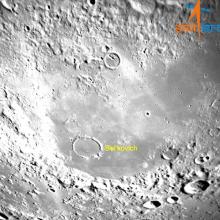Listen to today's episode of StarDate on the web the same day it airs in high-quality streaming audio without any extra ads or announcements. Choose a $8 one-month pass, or listen every day for a year for just $30.
You are here
Moon and Aldebaran
The Moon is a bit more than 236,000 miles from Earth this evening — a couple of thousand miles closer than average.
The Earth-Moon distance changes from day to day because the Moon’s orbit is lopsided. The average distance between Earth and Moon changes, too — by an inch and a half per year.
Scientists measure the distance by bouncing laser beams off special reflectors carried to the Moon by Apollo astronauts, and on the Soviet Union’s unmanned rovers. The experiments — most of which have been conducted at McDonald Observatory — reveal the Moon’s distance to within a fraction of an inch. Over the decades, they’ve shown that the Moon is inching away.
The change is caused by the gravitational interaction between Earth and the Moon. As the Moon orbits Earth, its gravitational pull creates tides, causing Earth to rotate a bit slower. But the overall momentum in the Earth-Moon system stays constant. So to balance the slowdown in Earth’s rotation, the Moon moves farther away.
Models suggest that the Moon formed when another planet hit the young Earth, blasting debris into orbit. The Moon coalesced from that debris at a distance of just 25,000 miles. At the same time, Earth’s day probably lasted just six hours. So a night was barely long enough for a stroll under the brilliant Moon.
Look for the Moon in the west during twilight this evening. The star Aldebaran will stand close to the upper left of the Moon.
Script by Damond Benningfield





